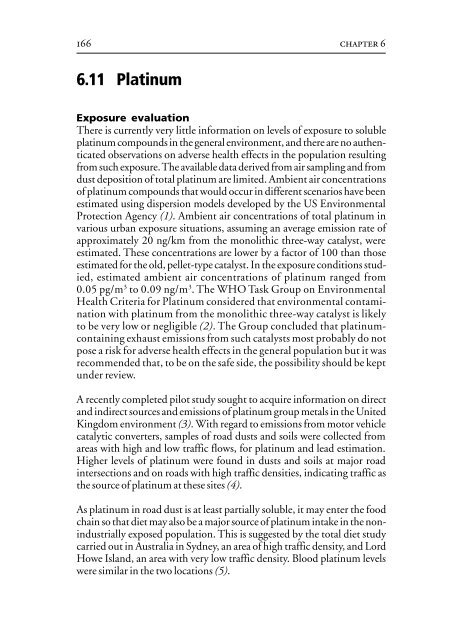Air Quality Guidelines - World Health Organization Regional Office ...
Air Quality Guidelines - World Health Organization Regional Office ...
Air Quality Guidelines - World Health Organization Regional Office ...
Create successful ePaper yourself
Turn your PDF publications into a flip-book with our unique Google optimized e-Paper software.
166 chapter 6<br />
6.11 Platinum<br />
Exposure evaluation<br />
There is currently very little information on levels of exposure to soluble<br />
platinum compounds in the general environment, and there are no authenticated<br />
observations on adverse health effects in the population resulting<br />
from such exposure. The available data derived from air sampling and from<br />
dust deposition of total platinum are limited. Ambient air concentrations<br />
of platinum compounds that would occur in different scenarios have been<br />
estimated using dispersion models developed by the US Environmental<br />
Protection Agency (1). Ambient air concentrations of total platinum in<br />
various urban exposure situations, assuming an average emission rate of<br />
approximately 20 ng/km from the monolithic three-way catalyst, were<br />
estimated. These concentrations are lower by a factor of 100 than those<br />
estimated for the old, pellet-type catalyst. In the exposure conditions studied,<br />
estimated ambient air concentrations of platinum ranged from<br />
0.05 pg/m 3 to 0.09 ng/m 3 . The WHO Task Group on Environmental<br />
<strong>Health</strong> Criteria for Platinum considered that environmental contamination<br />
with platinum from the monolithic three-way catalyst is likely<br />
to be very low or negligible (2). The Group concluded that platinumcontaining<br />
exhaust emissions from such catalysts most probably do not<br />
pose a risk for adverse health effects in the general population but it was<br />
recommended that, to be on the safe side, the possibility should be kept<br />
under review.<br />
A recently completed pilot study sought to acquire information on direct<br />
and indirect sources and emissions of platinum group metals in the United<br />
Kingdom environment (3). With regard to emissions from motor vehicle<br />
catalytic converters, samples of road dusts and soils were collected from<br />
areas with high and low traffic flows, for platinum and lead estimation.<br />
Higher levels of platinum were found in dusts and soils at major road<br />
intersections and on roads with high traffic densities, indicating traffic as<br />
the source of platinum at these sites (4).<br />
As platinum in road dust is at least partially soluble, it may enter the food<br />
chain so that diet may also be a major source of platinum intake in the nonindustrially<br />
exposed population. This is suggested by the total diet study<br />
carried out in Australia in Sydney, an area of high traffic density, and Lord<br />
Howe Island, an area with very low traffic density. Blood platinum levels<br />
were similar in the two locations (5).

















